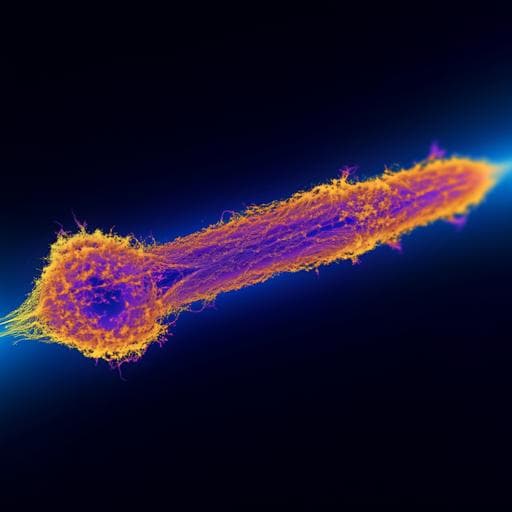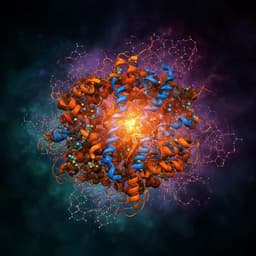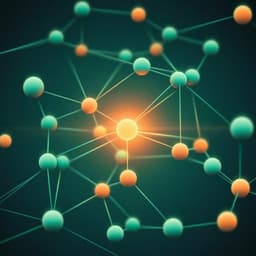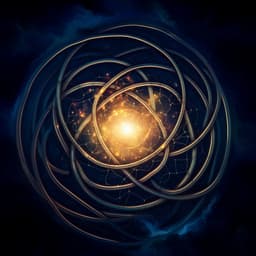
Physics
Transient lensing from a photoemitted electron gas imaged by ultrafast electron microscopy
O. Zandi, A. E. Sykes, et al.
Explore groundbreaking research by Omid Zandi and colleagues as they harness ultrafast electron microscopy to visualize the dynamic transformation of a 3D photoemitted electron gas in a magnetic field, revealing intriguing periodic oscillations and lensing effects. This work paves the way for deeper insights into electron and plasma dynamics.
~3 min • Beginner • English
Introduction
The paper addresses how to directly visualize ultrafast charge carrier dynamics—particularly the collective motion of a photoemitted electron gas—in real space and real time under a magnetic field. The context spans chemistry, solid-state physics, plasma physics, and high-brightness electron sources, where carrier motion unfolds on fs–ns timescales and Å–µm length scales. Ultrafast electron microscopy (UEM) enables such visualization by pump-probe imaging within a TEM. The study’s purpose is to observe and characterize cyclotron dynamics and associated mean-field lensing effects of a 3D photoemitted electron gas, offering a pathway toward imaging cyclotron motion in confined electron-gas systems (e.g., 2D electron gases) and informing development of bright electron/X-ray sources. The work is important because cyclotron resonances and Landau quantization reveal fundamental carrier properties (effective mass, mobilities, scattering times), traditionally accessed via THz/microwave spectroscopies without spatial resolution; UEM could add spatially resolved insight with ps temporal resolution.
Literature Review
Confined electron gases exhibit phenomena such as high mobilities, quantum Hall effects, Shubnikov-de Haas oscillations, anomalous de Haas–van Alphen effects, and superradiant damping. Cyclotron resonances in 2D electron gases have been extensively probed by THz/microwave spectroscopies to extract band structure parameters, effective masses, carrier densities, mobilities, and coherence times, often at low temperatures and strong magnetic fields where Landau levels dominate. Prior scanning probe imaging has spatially resolved carrier density variations in 2D systems, but without femtosecond–picosecond temporal resolution. Transient electric fields from photoinduced electron plumes have been seen in ultrafast diffraction/microscopy; however, a detailed study of space-charge dynamics in a magnetic field with its imaging consequences had not been reported. This work bridges these domains by adding real-space, time-resolved visualization in a TEM of cyclotron dynamics and mean-field lensing from a photoemitted 3D electron gas.
Methodology
Experimental setup: A custom-modified environmental TEM (Hitachi H9500) operates at 300 keV with a high-repetition-rate fs laser system. Pump: 528 nm, ~200 fs, ~30 mJ/cm², 490 kHz repetition, incident at 37° relative to the sample plane. Probe: short electron pulses (<1 ps nominal; instrument response ~500 fs) generated by 256 nm UV fs pulses on a LaB6 photocathode; repetition synchronized at 490 kHz with adjustable delay. Integration time per frame: 1 s (~5×10^5 shots). Sample: 3000 mesh copper grid (~4.5 µm hexagonal holes, ~5 µm thickness), tilted 15° toward the pump; transmission 34%. Photon energy (2.35 eV) is half the Cu work function (4.5–4.7 eV), leading to two-photon photoemission; fluence below ablation threshold. The objective lens provides a weak magnetic field along the electron-optical axis (z) in low-magnification mode; the first intermediate lens (IL) is adjusted to set defocused imaging conditions to capture angular deflections caused by the electron cloud’s fields.
Data acquisition and analysis: Movies recorded as real-space images; images normalized by total intensity; median filter (5×5) applied; difference images formed by subtracting a pre-time-zero average and a pump-only frame. Region-of-interest (ROI) circles used to track intensity changes. Fast Fourier transforms (FFT) of ROI traces determine cyclotron frequency.
Imaging conditions: Defocused imaging necessary to convert angle changes into intensity changes. By varying intermediate lens current (ILC), the post-sample crossover shifts produce barrel distortion (magnifying) at low ILC, in-focus double-peak ROI behavior at intermediate ILC (with astigmatic focal spots), and pincushion (demagnifying) distortions at high ILC. Objective lens current (OLC) controls magnetic field strength; OLC vs cyclotron period measured and converted to B via T = 2π m_e / (e B), yielding a linear OLC–B relation consistent with manufacturer data.
Analytical model: For t > ~50 ps, after early strong space-charge effects set the velocity distribution, the electron gas is modeled as a cylindrically symmetric Gaussian with time-dependent transverse radius σ_r(t) and axial radius σ_z(t). Under uniform B, transverse dynamics are periodic (cyclotron motion), leading to periodic narrowing of σ_r(t) with period T. Using Gauss’s law for an effectively long charged cylinder (as σ_z becomes much larger than σ_r), the radial electric field is linear in r near the axis, imparting a thin-lens effect on probe electrons. Assuming interaction time is short relative to gas evolution and using a thin-lens approximation, the time-dependent focal length f_EG(t) of the electron-gas lens is derived to be inversely proportional to the number of electrons N and to follow the same periodic dependence as σ_r(t), with maxima in lensing strength at integer multiples of the cyclotron period. For highly excited ILC (>1 A), ROI intensity change ∝ 1/f_EG(t), enabling fits to 1/f_EG(t) ≈ A e^{-t/τ} g(t), where A encodes N and TEM lens parameters, τ accounts phenomenologically for loss/dephasing, and g(t) captures the periodic cyclotron modulation; σ_0 (minimum transverse radius) is set by the two-photon emission footprint (σ_0 = 12/√2 µm from a ~28 µm FWHM effective spot).
Numerical simulations: N-body simulations compute dynamics under Lorentz force F = q (E + v × B) with small time steps (80 fs). Initial cloud: 3D Gaussian oblate slab (~2 × 2 × 0.01 µm^3) containing 10^4 electrons, placed 30 nm above the copper surface; initial velocities Gaussian with mean (0,0,6×10^5 m/s) and isotropic spread 6×10^5 m/s. Fields include self-Coulomb interactions, an external uniform B (e.g., 0.22 T in representative runs), and image charges modeled by mirror charges in a grounded planar conductor (copper grid approximated as a plane; electrons hitting the plane are absorbed). Retardation and radiation are neglected (v ≪ c for cloud electrons). Probe image simulations: 300 keV probe electrons (v ≈ 2.3×10^8 m/s) launched on a 14 µm square grid (11,025 electrons) starting 30 µm above the sample; detector plane 1 m below; no other TEM lenses modeled; ROI radius 7 µm for intensity traces. Simulated movies generated from N-body snapshots to compare with experiments.
Key Findings
- Real-space, picosecond-resolved visualization of cyclotron dynamics of a photoemitted 3D electron gas in a TEM magnetic field. A prompt Coulomb explosion is followed by periodic, long-lived oscillations that cause transient lensing and pronounced grid image distortions.
- Cyclotron frequency and period: Fundamental frequency ≈ 6.05 GHz (FFT of ROI trace), corresponding to T ≈ 165 ps. Angular frequency from analytical fit: ω ≈ 37.97×10^9 s^-1, consistent with 2πf.
- Magnetic field calibration: Cyclotron period varies linearly with objective lens current; converting via T = 2π m_e / (e B) yields a linear OLC–B relation matching manufacturer data. No oscillations at OLC = 0 A (B ≈ 0).
- Imaging behavior vs defocus: By varying intermediate lens current, observed barrel (magnifying) distortions at low ILC, an in-focus regime with a double-peak ROI structure and strong astigmatism at intermediate ILC, and pincushion (demagnifying) distortions at high ILC. Astigmatism arises from sample tilt and elliptical laser footprint; can be compensated by condenser stigmators.
- Mean-field lensing: The electron cloud acts as a diverging lens with a time-dependent focal length f_EG(t) that is periodic with the cyclotron motion and inversely proportional to N. Estimated focal length magnitude varies by about an order of magnitude during a period: ~0.5 m at lensing maxima and ~4–5 m between peaks.
- Electron-gas parameters from fits: Using a simplified post-sample lens model and ROI data at high defocus, the cloud contains N ~ 10^5 electrons; transverse velocity spread σ_v ≈ 4.91×10^5 m/s; decay constant τ on the order of several ns (limited by fitting window). Minimum transverse size set by two-photon footprint σ_0 ≈ 12/√2 µm.
- Shape transformation: N-body simulations show a rapid oblate-to-prolate transition. Within 165 ps, aspect ratio changes by ~10^4 (initial σ_r/σ_z ~ 0.005 to σ_z/σ_r ~ 50), with charge density dropping by ~2×10^4 due to shape change and partial absorption by the grid. Longitudinal expansion proceeds at ~6×10^5 m/s; axial extent reaches ~1.5 mm by 3 ns.
- Early-time dynamics (<50 ps): The first lensing peak appears delayed (~4–12 ps) and is consistently smaller than the second peak (first/second ≈ 0.3–0.5). This is attributed to the early oblate geometry (weak transverse field) and suppression by image charges (parallel-plate-like dipole field). Including the copper grid (image charges and absorption) in simulations is essential to reproduce this amplitude ratio.
- Persistence and damping: Oscillations persist for >20 cycles (~4 ns). Damping/contrast loss attributed to continued electron absorption (~10% over ~6 ns) and dephasing due to magnetic field nonuniformity away from the eucentric plane; potential losses to pole pieces at long times.
- Mean-field dominance: The observed probe deflections are dominated by cooperative mean-field space-charge effects rather than discrete particle-particle scattering at the velocities considered.
Discussion
The observations directly address the central question of how a photoemitted electron gas evolves under a static magnetic field and how its collective fields affect imaging electrons. The periodic narrowing of the transverse size at each cyclotron period concentrates charge density, maximizing the transverse electric field and thus lensing strength, which maps onto magnification/demagnification patterns in defocused images. The rapid oblate-to-prolate transformation significantly enhances lensing after the initial few picoseconds, explaining the delayed and weaker first peak relative to subsequent resonances. The analytical model captures the periodicity and allows estimation of electron number and velocity spread; deviations at early times necessitate inclusion of self-Coulomb fields, image charges, and the absorbing boundary, which are incorporated in N-body simulations that reproduce the amplitude ratios and qualitative image features. The results demonstrate that probe deflections are governed by the mean-field created by the ensemble, enabling a thin-lens description with time-varying focal length. This capability paves the way for spatially and temporally resolved visualization of cyclotron motion in material systems (e.g., 2D electron gases), complementing frequency-domain THz methods by adding spatial resolution and real-space dynamics.
Conclusion
This work demonstrates ps-resolved, real-space imaging of cyclotron dynamics of a hot, photoemitted 3D electron gas in a TEM magnetic field and reveals a transient, cooperative mean-field lensing effect that distorts probe images. An analytical framework provides a time-dependent focal length and order-of-magnitude estimates of electron number and velocity spread, while N-body simulations including self-fields, image charges, and absorption explain the early-time behavior and the oblate-to-prolate shape transformation. The approach offers a route to visualize cyclotron dynamics and charge separation in photoexcited materials and to characterize photoemitted beams relevant to high-brightness electron and X-ray sources. Future directions include systematic studies versus laser wavelength and fluence (tuning photoemission order), application of sample bias to explore regimes below the virtual cathode limit, experiments at low temperature to probe 2D electron gases with long diffusion lengths (e.g., InSb, InAs, GaAs/AlGaAs, oxides), implementation of quantum point contacts for imaging coherent flow and magnetic focusing, and improvements in UEM technology (e.g., high-frequency chopping cavities, low-temperature operation).
Limitations
- Analytical model neglects Coulomb self-interactions, image charges, and electron absorption by the grid; thus, it does not quantitatively capture early-time (<50 ps) dynamics.
- Magnetic field nonuniformity away from the eucentric plane induces dephasing and damping of oscillation contrast; this is only phenomenologically included via an exponential decay factor in fits.
- TEM lensing system after the sample is simplified; quantitative focal length values are order-of-magnitude estimates and depend on instrument-specific settings.
- N-body simulations approximate the copper grid as a grounded plane (ignoring hole geometry and sample tilt) and neglect retardation and radiation losses; probe-probe Coulomb interactions and back-action of probe on the cloud are neglected.
- Exact instrumental response function is not independently measured; while much shorter than the cyclotron period, it introduces some uncertainty in temporal resolution. Long-time losses to pole pieces and field gradients are not fully modeled.
Related Publications
Explore these studies to deepen your understanding of the subject.







